Japanese Soups | Soup culture and the different kinds of soups
Soup is a primarily liquid food, generally served warm (but may be cool or cold), that is made by combining ingredients such as meat and vegetables with stock, juice, water, or another liquid.
Hot soups are additionally characterized by boiling solid ingredients in liquids in a pot until the flavors are extracted, forming a broth.
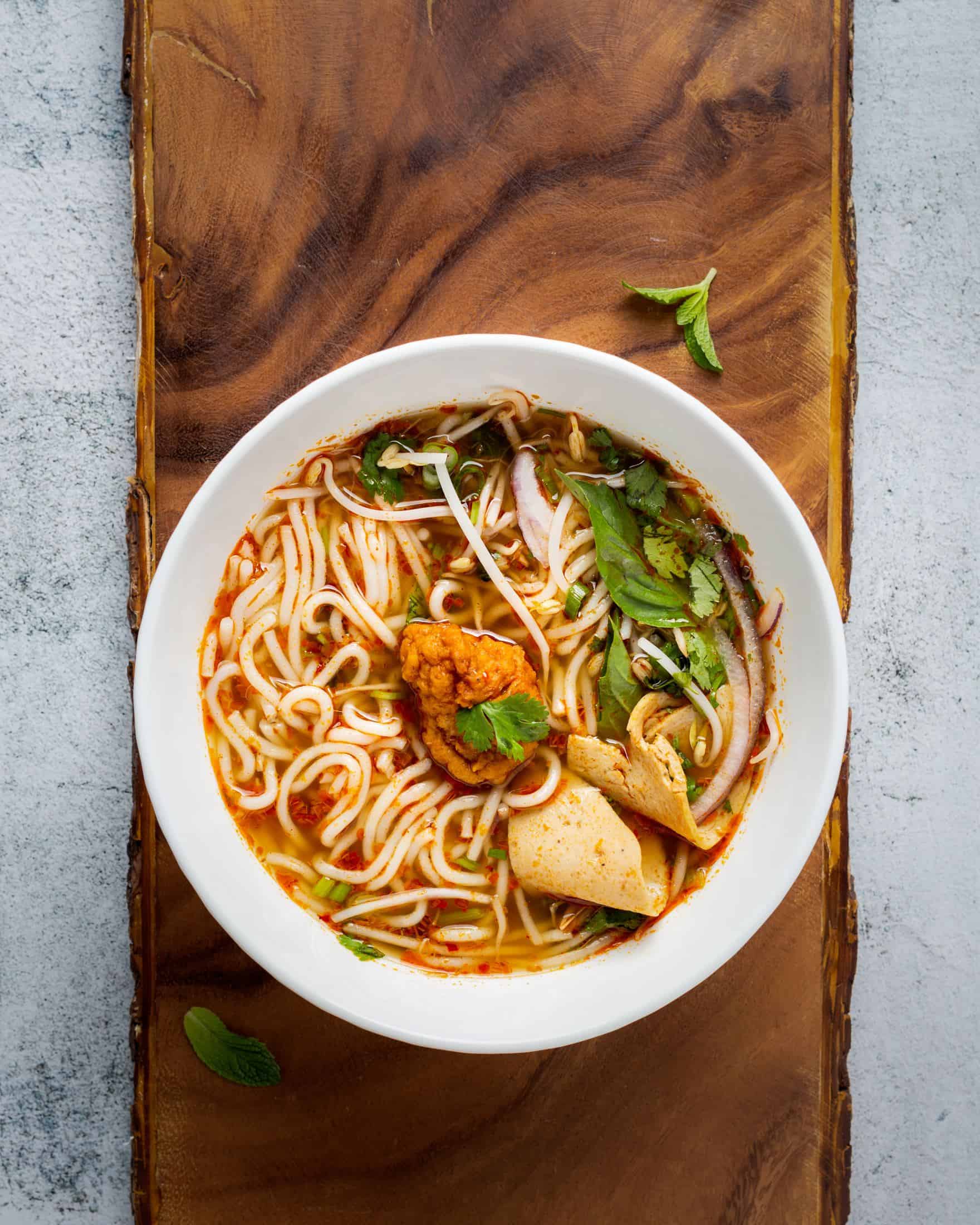
Traditionally, soups are classified into two main groups: clear soups and thick soups.
Soups have a special place among Japanese cuisines.
From home-cooked meals to teishoku sets (multi-course meals served all at once) offered at restaurants, the Japanese people follow their time-honored tradition known as ichiju issai (“one soup, one side”) and ichiju sansai (“one soup, three sides”), which is based on the principles of balanced eating.
In food preparation, this is translated to the Japanese standard meal structure where there should be a bowl of rice, a soup to add flavor to the rice, and either 1 or 3 small side dishes laid out on the table in order to achieve the greatest nutritional balance.
This is a traditional Japanese breakfast with miso soup, rice, and three sides:
Most Japanese soups are made with a few ingredients and are not extravagant; however, all soup recipes in Japan have a dashi stock in them.
It adds the savory flavor (umami) to each and every soup or dish and the chefs make each recipe that reflects the flavors of the season.
There are approximately 34 different kinds of Japanese soups, stews, and nabe, and learning of this stuff will make you want to try and cook them yourself just to sample each of them for your pleasure.

Check out our new cookbook
Bitemybun's family recipes with complete meal planner and recipe guide.
Try it out for free with Kindle Unlimited:
Read for freeIn this post we'll cover:
Asian Soups Have the Most Variety in the World
If you go food exploring in Asia, then you will find almost all of them taste great and those that have dashi in them are to die for.
The variety of Asian soups differs from country to country, but they are indeed plentiful – more than you can sample in one day. They are so simple to prepare and so distinctive in their flavors that you will spend half of your vacation doing food or soup shopping.
Among the very best include the Tom Yam Kung (Thai Hot and Sour Soup with Shrimp), Chinese Napa Cabbage Soup, and Japan’s very own Miso Soup.
It’s also known as “suimono.” You can use that base as well, but most people prefer just this simple broth variation.
If you garnish it with spinach leaves and shrimps, then the dashi stock and the overall flavor of the seafood and vegetables will enhance the soup’s taste even further.
Japanese soups are designed to stimulate your taste receptors and not satisfy your stomach, but eating a bowl or two of rice with it is a good enough meal that will last you through the day.
The nabe yaki udon is the opposite of the miso soup because it has a lot more ingredients and is quite delicious as well.
There are over 150 Asian soups you can try and almost all of them are very delicious!
The 4 Primary Soup Stocks in Japan
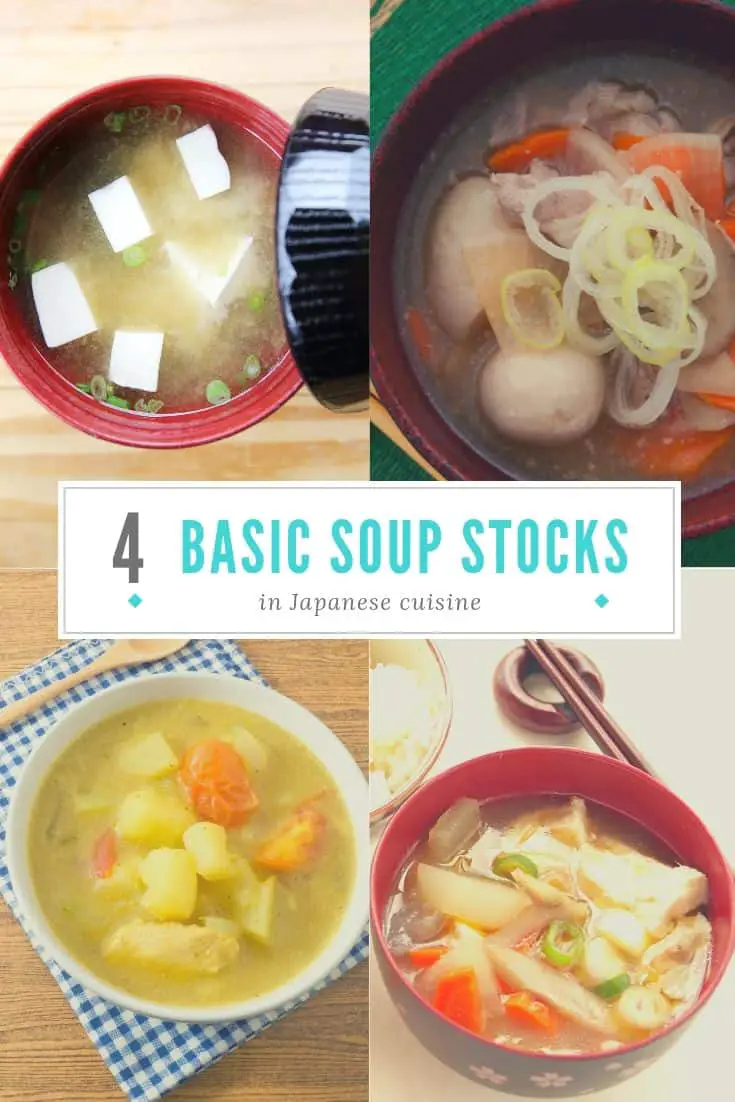
Going back to the Japanese food tradition ichiju issai and ichiju sansei, there are 4 institutionalized primary soup stocks that every Japanese chef and cook use in all of their cuisines.
For them, a proper meal is not complete without any of the 4 soup stocks, which include the miso soup, the tonjiru (pork-miso soup), the meat-potato soup, and the rice vegetable soup.
Not only are these soup stocks delicious as they are all made with dashi, but they are very nutritious too!
Below you will find the 4 primary soup stocks used by Japanese chefs for thousands of years:
Miso Soup
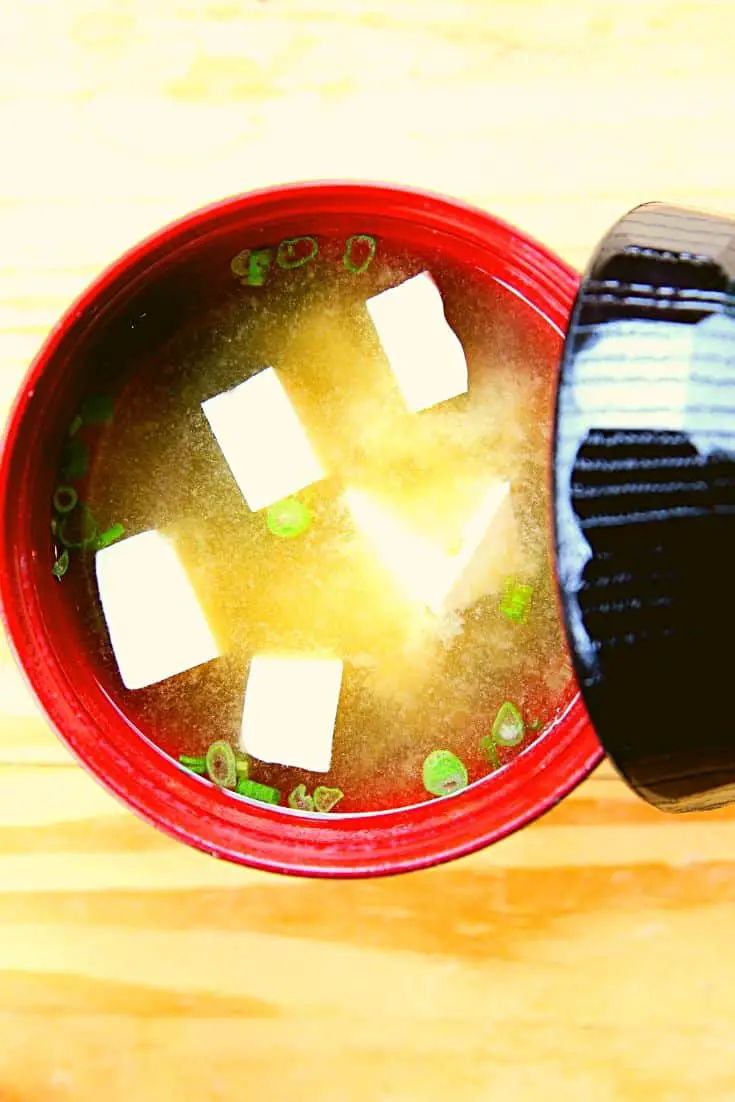
The most basic kind of miso soup (みそしる) includes tofu squares, seaweed, and a soup stock called だし (dashi), but there are many different kinds of soups in Japan.
This one though is sometimes used as a soup stock for other dishes.
The dashi can be extracted from dried kelp, fish, or mushrooms by mixing and/or simmering them with water.
It is a common thing to see a bowl of rice served along with the miso soup. Miso soup is so famous in Asia that you can find them being sold in convenience stores in the form of a paste.
Drop the miso paste in boiling water and in a few minutes it becomes a miso soup or just plain miso soup, but you can add other ingredients to it if you want.
Pork-Miso Soup (Tonjiru)
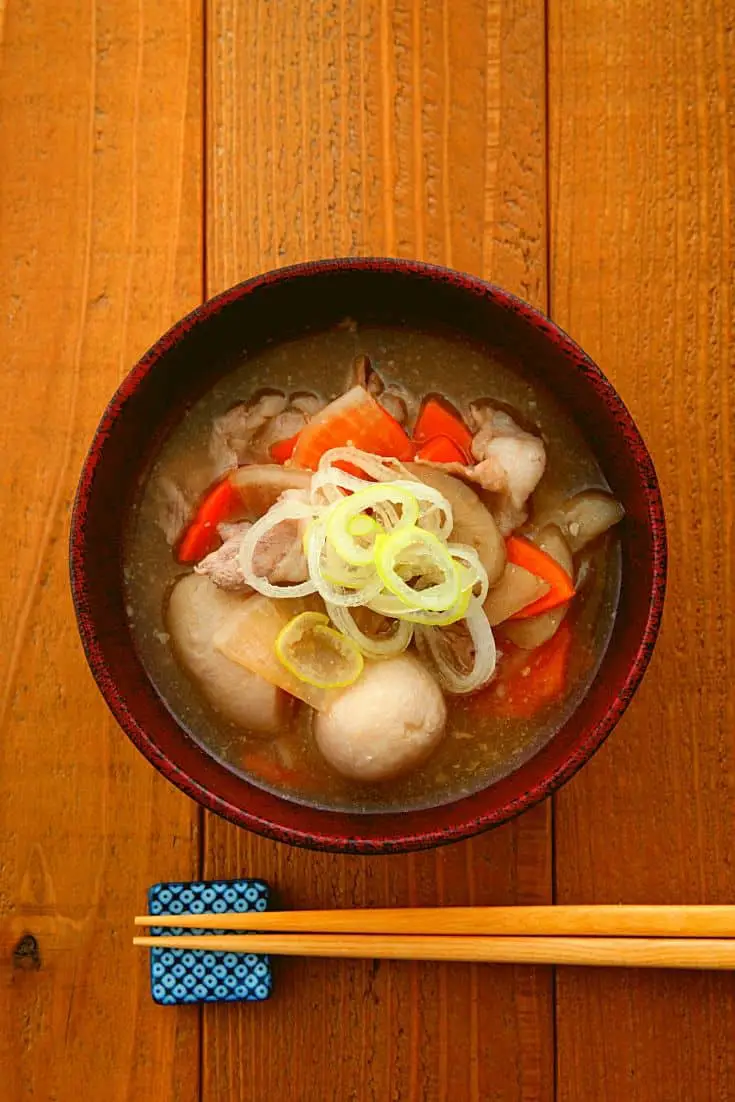
Tonjiru (とんじる) also called butajiru or pork soup (ぶたじる) is a pork, vegetable and miso paste soup.
Among the vegetable ingredients of this soup are green onions, carrots, sliced onions, and potato squares. The preferred slice of the pork meat is thin, so it could absorb the flavor or the miso soup.
After 5 – 10 minutes you may add the pork slices to the tonjiru as the meat ingredient to the recipe.
This is a great way to make the tonjiru taste even better and you can also buy the tonjiru or butajiru in aluminum packs in most convenience stores in Japan also.
Meat-Potato Soup
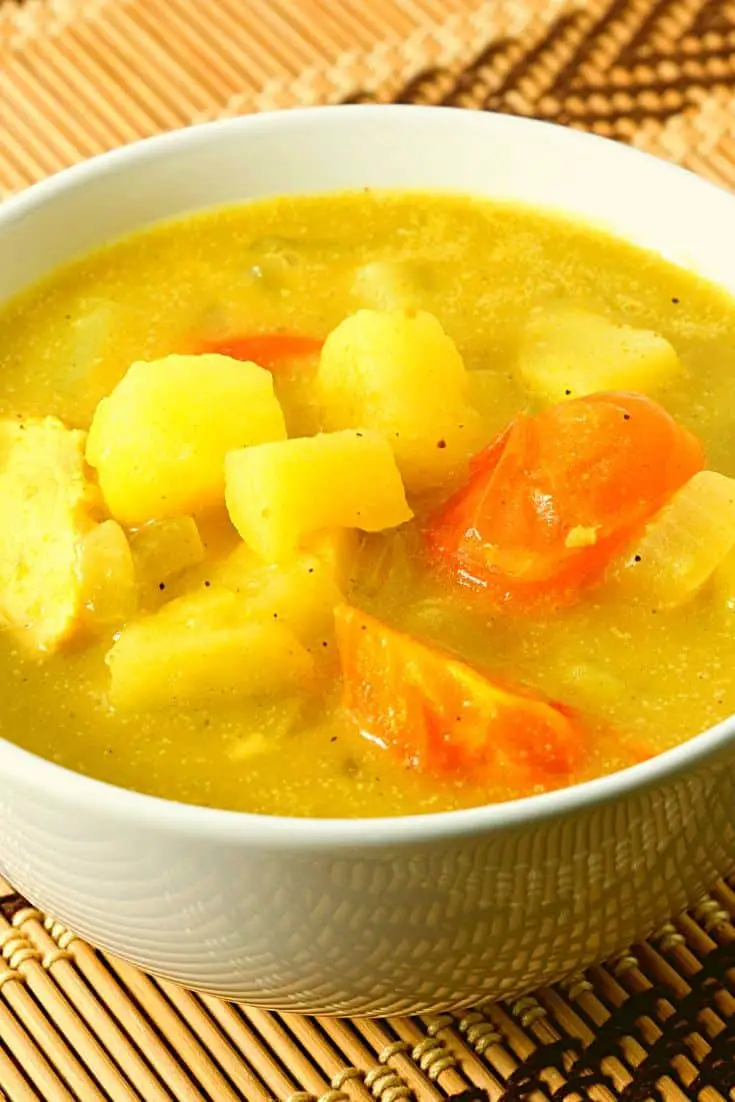
The meat-potato soup (いもに) is another primary soup stock used in Japanese cuisines on a daily basis. The “meat” portion of this recipe may include any type of meat like pork, beef, chicken, fish, or seaborne meat.
It is a popular food served outdoors and has some basic ingredients of soy sauce and sugar.
The ingredients may include miso paste, carrots, cabbage, mushrooms, tofu, beef, and thinly sliced pork; however, it varies from region to region but you can always tell if it’s a meat-potato soup because it has miso paste and meat in it.
This soup is common during the autumn months (mind you, the Japanese base their dishes on the seasons) and, as a matter of fact, tourists come to the Yamagata Prefecture just to try the meat-potato soup, which is famous in that region.
Rice-Vegetable Soup
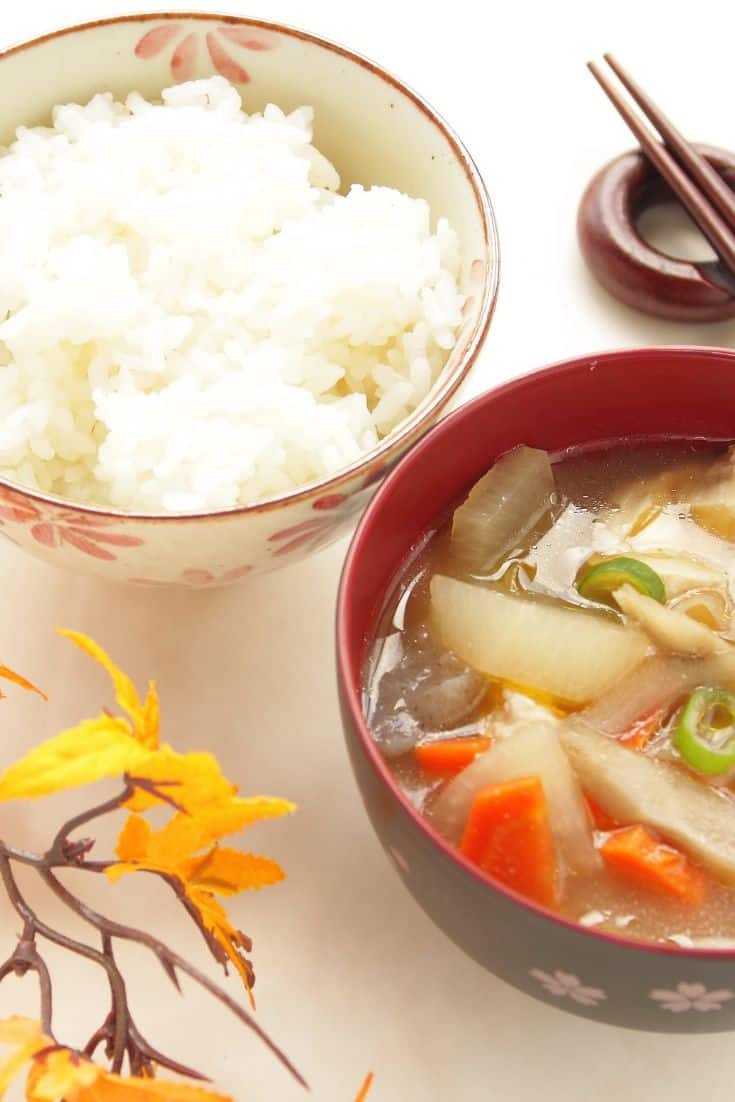
Finally, the rice-vegetable soup (ぞうすい) makes up the fourth soup stock in this list and is essential to the Japanese meal structure.
The most common rice-vegetable soup is the one that has chicken in its ingredients, but there are various kinds of this soup in Japan.
You’ll need to cook the rice in a rice cooker (like one of these top rice cookers we’ve reviewed) first before adding it to the dashi, mushrooms, radish, seaweed and green onions.
Although its therapeutic claims about curing colds and allergies have not been approved by Japan’s Pharmaceuticals and Medical Devices Agency (独立行政法人 医薬品医療機器総合機構), a lot of people say that it can cure colds and flu.
It is also commonly eaten during cold and chilly days as it warms up the stomach and the whole body as well.
Why Asians, Especially Japanese People, Love Soups
Soups and porridges have been around since the Cro Magnon man appeared on Earth and perhaps people from before the Upper Paleolithic Era, which was some 40,000 years ago, probably ate some form of soup as well.
Somehow the reason for consuming this kind of food appears to be the same across continents and cultures – to keep the body warm from the cold environment.
Although soups have a lot of nutritional benefits it was never considered by the people who created it until now.
The people of Asia seem to love eating soups more than any other people in the world and there are over 10 dozen kinds of soups to prove that!
We may never know the real reason why Asians love soups so much, but maybe the reason is simply that it’s delicious and nutritious.
All the Known Japanese Soups and Stews
Soup is a primarily liquid food, generally served warm or hot (but may be cool or cold), that is made by combining ingredients of meat or vegetables with stock, or water.
Additionally, hot soups are made by boiling the solid ingredients in a pot in order to extract the flavors from them which then becomes the broth. This is where the taste of the soup comes from and is the reason why it’s so addictively delicious.
In Japan, they make the dashi first in order to get the savory flavor called umami, and then they add the dashi to the soup, which further enhances the savory taste of it.
Sometimes it’s hard to differentiate soups and stews as they’re practically similar; however, soups are made with more liquid (broth) in them when compared to stews.
Below you will find all kinds of Japanese soups and stews classified into 4 categories which are the soup (しるもの shirumono), noodle soup (めんつゆ men tsuyu), stew (煮物 boiled food or シチュー shichū), and hot pot (鍋物, なべ物 nabemono):
Category I: Soup (Shirumono)
Butajiru – (ブタジル) also called tonjiru, is a soup made with pork, vegetables, and miso paste.
An improvement from the simple Japanese miso soup, the butajiru, or tonjiru incorporates a wide array of ingredients, especially vegetables, that includes but not limited to the slightly sweet gobo root, taro roots, carrots, and daikon (traditional root vegetables).
At the heart of butajiru is the dashi stock which makes it very delicious!
Other ingredients include scallions, tofu, ginger, and the gelatinous konnyaku; however, you can always choose your own variation of ingredients to fit your preferences with the butajiru.
All ingredients are thinly cut and sliced in order to ensure fast and convenient preparation.
Even though at the core of the butajiru is just the simple miso soup, it becomes a completely different kind of soup once the flavorful pork and aromatic vegetables are added to the mix.
The butajiru is characterized by complex and layered flavors and is traditionally served warm (to combat the cold winter season), often accompanied by plain white rice.
Dashi – (だし) is a broth or soup stock commonly used in almost all Japanese cuisines.
Also read: this is katsuobushi, the dried fish used in dashi
Our tongues are quite partial to umami flavors which is why strong, intensely flavored foods, especially when paired together can give an even more intense flavor.
Dashi is one of the five basic tastes (sweet, sour, bitter, savory/umami and salty) that our taste receptors are very sensitive to, which is why it’s very appealing to us humans.
Dashi is extracted from any of these 4 elements:
- Kombu (a type of seaweed or kelp)
- Shitake Mushrooms
- Bonito (the mackerel tuna’s cousin)
- Iriko (sardines or anchovies)
The dashi stock has been discovered and used for over 800 years now and even in Western restaurants, professional chefs recognize its potential for stimulating the guests’ sense of taste and use it in some of their dishes.
Sweet Corn Porridge Soup – also called corn potage (コーンポタージュ) is a French-influenced Japanese corn soup that’s rich, creamy and ultra-smooth.
Made with sweet corn, onion, butter, potato, milk, salt, parsley, and sandwich bread derived from the yōshoku (洋食), or western-style food, particularly the French corn soup.
It was adopted into the Japanese cuisine during the Meiji Era (1868 – 1912) and has been called the corn potage ever since.
Kasujiru – (郷土料理ものがたり) this soup can be made with either fish (salmon or yellowtail) or pork mixed with daikon, konjac, aburaage (thin deep-fried tofu), naganegi (long green onions), dashi stock, miso paste, sake kasu or sake lees (酒粕) and carrot root vegetable.
This dish will warm you from the inside out! That’s because it has sake kasu in it, so technically you don’t need any alcohol to pair this soup with when you eat it.
Kenchin Jiru – (郷土料理ものがたり) sometimes spelled kenchin-jiru (literally translated as “local cuisine”) is a vegetable soup famous in Kamakura, Kanagawa Prefecture, Japan that uses root vegetables and tofu as its main ingredients.
People often refer to it as just kenchin and although the traditional method is to use tofu and root vegetables to prepare it, you are free to do variation in the ingredients as well as the methods to prepare it depending on what kind of taste you want the soup to bring about.
It believed by locals that this soup originated in Kenchō-ji, a temple (a Chinese Zen temple) and is rooted in the shippoku (桌袱) cuisine – a Japanese-Chinese fusion or hybrid cuisine.
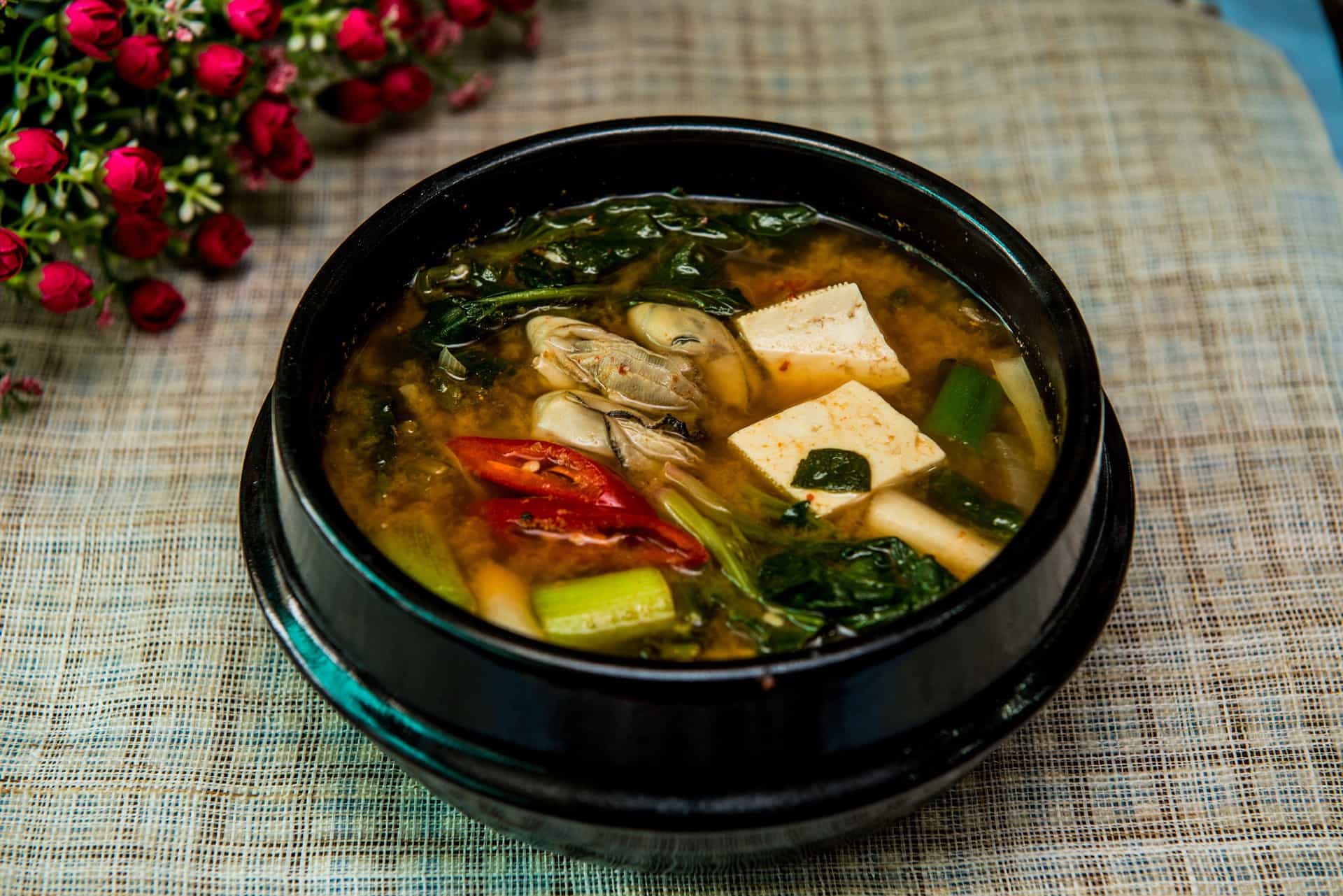
Miso soup can be prepared in multiple ways and each variation depends on personal preferences as well as regional and seasonal recipes.
The miso soup is classified under suimono (clear soup) but the two can be independently identified. Still, they are interchangeable nowadays.
The miso soup also has another important character-defining flavor ingredient, which is the miso paste.
As if the dashi stock in the miso soup is not enough, right?
The miso paste is made from fermented soybeans that have been added with salt and the fungus known as Aspergillus Oryzae (kōjikin 麹菌 in Japanese), barley, rice, and other elements are also added to the paste, and it can technically be categorized into the red (akamiso), white (shiromiso), or mixed (awase).
You can find a lot of variations of the miso soup throughout Japan, most notably are the regional variations such as Sendai miso soup or the Shinshū miso soup.
Noppe – (のっぺい noppei, also 濃餅 or 能平) is a traditional vegetable stew that Japanese people enjoy eating.
Like most Japanese dishes this one too is called by many names in every prefecture in Japan; however, the most famous variation of this stew is the one made in Niigata which is called interchangeably noppe-jiru, noppei, or just simply noppe.
The way noppe is made will surprise you because the stew’s ingredients are left-over vegetable parts that are boiled or sautéed in sesame oil.
The ingredients and thickening agents used to create the stew is different in every town and region, but usually, they use fried tofu, konjac, shitake mushrooms, carrots, and yams.
All of the ingredients are boiled in a pot of water for several minutes, then soy sauce, salt, and starch are added to the mix as thickening agents.
Noppe can also include fish and meat in its ingredients to get more defined flavors.
The noppe is mostly eaten in the Niigata region, especially during New Year celebrations, festivals, and Buddhist ceremonies.
Ohaw – (オハウ) also called rur and created by the northern Ainu people of Japan is a savory soup flavored with fish or animal bones belonging to the suimono (clear soups) category.
Kelp is another flavor catalyzing ingredient of this stock in order to invigorate it.
The Ainu people of northern Japan are considered the original ancient race that lived in Japan before the Common Era and they have traditions that are different from those Japanese in Tokyo or other regions of the land.\
So it’s not unusual to know that they do not use soy sauce or miso or dashi stock in the ohaw soup.
They just most of the ingredients like wild edible plants, vegetables, fish, and meat directly to the soup while it is being prepared and make the umami stock from them.
Suimono – (すいもの) is a savory liquid (broth) which is made of vegetables, meat, or bones-infused water by simmering the solid ingredients in boiling water.
It is also a generic name used by Japanese to describe traditional soups that are clear or light in color.
You may eat it as is; however, it is commonly used as a stock to make soups, gravies and sauces.
Ushiojiru – (ウシオジル) also known as Hamaguri Ushio-jiru (Clear Clam Soup) is a soup made with a clear broth and clams.
Hamaguri (蛤) means “common hard clams” and jiru as we’ve earlier discussed means “soup.”
The main ingredients of the ushiojiru include small clams, kombu, water, salt, parsley, cilantro, or mitsuba, and lemon zest.
Torijiru – (トリジル) the typical chicken soup in Japan is called torijiru.
Preparing the torijiru starts with making the dashi or buying it from a grocery store.
They do not boil the chicken like Westerners do because it’s hard to purchase whole chicken in Japanese supermarkets.
Once the dashi is ready, it will be poured in the pot together with boneless chicken thigh meat pieces.
The water will be allowed to boil and then the vegetables such as the taro root, potatoes, mushrooms, welsh onion, konnyaku, burdock, carrot, and daikon radish will be added.
Just before the chicken soup is ready different kinds of seasonings are added to it and the seasoning style will depend upon which region of Japan the torijiru is made.
It could be a miso-based soup or soy sauce-based.
Vinegar, salt, mirin, and sake are also used with the miso or soy sauce.
The pork-based soup (butajiru) which is an analogue of the torijiru is also more popular than the chicken soup.
The bone stock (broth) used for ramen noodle soups are often made with chicken broth and is used in almost every occasion for the less common variety of kotteri.
Zenzai – (ぜんざい) or a red bean soup that has kirimochi (sweet rice cakes) in it.
It is actually a Chinese dish called hong dou tang (紅豆汤) that the Japanese adopted into their own culinary art.
In the Okinawa Prefecture, zenzai refers to a red bean soup served over shaved ice with mocha.
Zōni – (雑煮), often with the honorific “o-” as o-zōni, is a Japanese soup containing mochi rice cakes.
The Japanese strongly associate this dish with their tradition of osechi ceremonial foods and their New Year festivities.
Preparing the zōni is different per region and household, and it is considered the most auspicious of the dishes when eaten on New Year’s Day.
Category II: Noodle Soup
Champon – (ちゃんぽん ) is a noodle dish that is a regional cuisine of Nagasaki, Japan.
The champon was originally a Chinese cuisine that was later adopted by the Japanese and the Koreans as both countries have different versions of Champon.
Before the champon is made, the combo broth of pig and chicken bones is prepared first.
Then pork strips are fried in lard instead of oil, together with seafood and vegetables in a frying pan.
Once the primary ingredients are cooked, the combo broth is then poured into it and that becomes the champon.
Especially made ramen noodles for the champon are later added and boiled in the same pan or pot (the noodles do not need to be boiled separately like in other ramen soups).
As you may already know, the Japanese cook their dishes differently in each season that comes; so depending on where and what time of the year you will eat the champon, it will have different ingredients and varying tastes.
Hōtō – (ほうとう) Yamanashi’s popular traditional noodle soup, hoto is made by stewing a mix of vegetable and udon noodles ingredients in a miso soup stock.
Though hōtō is commonly recognized as a variant of udon, locals do not consider it to be an udon dish because the dough is prepared in the style of dumplings rather than noodles.
In its etymology the word “hoto” is often associated with hakutaku (餺飥), most experts even suggest that it is the euphony of hakutaku – the name given to udon flour once it is kneaded and cut.
There is also a variant called azuki bean hoto (小豆ぼうとう azuki bōtō) that refers to the red bean soup with hōtō noodles added in place of the traditional ingredients like mochi or shiratama.
Instant Noodles – (インスタントラーメン) a type of noodle soup invented by the Japanese for quick-cooking meal soup on demand, thus the term “instant” has been attached to its name.
It is commonly made in factories, mass produced, pre-cooked and dried noodle block, with one or more flavoring powder, seasoning oil, and in some cases, soy sauce or dashi are included inside the packaging.
The flavoring can come in the form of a dry powdery substance, or oily or any other type of liquid seasoning, or a combination of the 3.
Dried vegetables are added too as well as dried shrimps chopped that becomes tender when hot water is added to the noodle or it is boiled in a pot.
Cup Noodles – (カップヌードル) is a type of instant noodles that is ready to eat and you just have to add hot water and sprinkle the powdered flavoring and oils or dashi onto it.
The first brand to hit the market was Nissin and it was also the same company that invented the cup noodle back in 1971.
The seal packed noodle is packaged in a foam food container, hard plastic or paper cup.
Soon after other companies launched their own cup noodle products and so far most of them have benefited from the success of the instant noodle industry.
The cup noodle product from Nissin has inspired other companies, not only in Japan but in other countries as well, to compete with it.
Some manufacturers even tried to variate their own ready-to-eat-meals like Maruchan’s Instant Lunch.
Okinawa Soba – (沖縄そば) Okinawa soba is a type of noodle soup and is a regional collective trademark of The Okinawa Noodle Manufacturing Co-op in Okinawa Prefecture, Japan.
The Okinawans simply call it soba or suba in the different dialects in the prefecture, although by Japanese tradition the word means buckwheat noodles.
The thick noodles made from wheat looks like udon, while the Okinawa Soba soup is more similar to ramen.
Ramen – (拉麺, ラーメン) is a Japanese noodle soup that originated in northwest China and is literally translates to “pulled noodles” due the process of producing it.
Today ramen soups have quite complicated ingredients as modern Japanese chefs often want to try to experiment in making ramen soups, but core ingredients remain the same.
Ramen starts with the Chinese-style wheat noodles cooked together with dashi stock, soy sauce or miso soup.
The basic toppings usually include the sliced pork (chashu), dried seaweed (nori), the condiment made from Lacto-fermented bamboo shoots (menma), and scallions. But it may vary from recipe to recipe.
Nearly every region in Japan has its own variation of ramens, such as the tonkotsu (pork bone broth) ramen of Kyushu and the miso ramen of Hokkaido.
Udon – (饂飩, usually written as うどん) is one of the most common noodle soup in Japan that is made out of flour and wheat and has a thick and flat appearance.
In its simplest form, it is just served as a hot and plain noodle soup called Kake udon, mixed with a mild-flavored broth called kakejiru, which is made of mirin, soy sauce, and dashi.
The toppings for a more complex udon soup can include scallions, mixed tempura fritter (mostly made of prawns) called kakiage, aburaage (deep-fried tofu pockets seasoned with sugar, mirin, and soy sauce).
Kitsune udon is just one of the many variations of udon and there are even stir-fried (dried) udon recipes too!
These Japanese dishes are delicious and traditional, check it out if you have the chance
Category III: Stew (Nimono)
Cream Stew – (クリームシチュー) is a well-known Japanese yoshoku (Western-influenced) cuisine that was borrowed from foreign dishes that consists of meat (usually pork or chicken) mixed with cabbage, potato, carrot, and onion, and is cooked in a thick white roux.
Gyusuji Nikomi or Motsu Nikomi – (牛筋煮込み) beef tendon stew or (もつ煮込み) stewed pork intestines are a class of Japanese delicious stews that typically uses beef parts to make the stew.
Beef tendon may not be a common ingredient in Western cultures, but it is loved for its luxurious textures and health benefits in Japanese and many Asian cuisines.
Also read: this is miso nikomi, a perfect hearty soup
Nikujaga – (肉じゃが) is a Japanese dish that’s made from meat, potatoes and onions stewed in sweetened soy sauce, or sometimes with ito konnyaku and vegetables.
More than half of the ingredients of the nikujaga are potatoes with the meat only being used as a source of flavor (cooked like a broth).
Zosui – (雑炊, literally “miscellaneous cooking”), or ojiya (おじや), is a rice-egg-vegetable soup popular in Japan with mild flavoring and thin ingredients.
It is made by cooking the rice in a rice cooker first and is seasoned with miso or soy sauce, then the cooked rice is mixed with other ingredients like vegetables, mushrooms, seafood, and some meat in a pot of water.
It is commonly served to people who have colds and flu or not feeling well and it is often served only in the winter (it is one of those seasonal-based soups).
Category IV: Hot Pot (Nabemono)
Chankonabe – (ちゃんこ鍋) is another popular Japanese stew that’s a type of nabemono (one-pot all-inclusive dish) usually the favorite of sumo wrestlers as they eat it in vast amounts in order to gain weight quickly.
This cuisine does not have a definitive ingredients list and the recipe may vary depending on the region and how the chef wants to prepare the dish.
But the common ones are meat for a high-protein diet, dashi, vegetables, herbs, spices, seafood, and other ingredients.
Fugu Chiri – (てっちり) is quite the popular Japanese dish known for its dangerous appeal, which is also called tetchiri and prepared in a hotpot-style; fugu chiri’s main ingredient is the fugu fish or the very poisonous pufferfish cooked with leeks, mushrooms, and cabbage.
It is cooked with a broth or dashi and then the fish parts (which contain some or most of the poison) are taken out, dipped in soy sauce, and consumed.
Around 45 people die each year in Japan from fugu poisoning and, in fact, the Japanese government has banned eating this dish.
The fugu chiri ban also created a cult as a result.
Harihari-Nabe – (はりはり鍋) is a type of nabemono (hotpot recipe) that has minke whale meat and mizuna (Japanese mustard greens, or spider mustard).
The dish is especially popular in the Osaka metropolitan area in the Kansai region of Japan.
The name of the dish actually came from the sound one makes when chewing the mizuna.
Imoni – (芋煮) is a seasonal dish (typically eaten during the autumn season) that’s made of taro roots and meat (usually beef) cooked with miso soup and is famous in the Tohoku region of Japan.
Kiritanpo – (きりたんぽ) is a popular dish that is believed to have come from the Akita Prefecture, Japan.
Kiritanpo is made by smashing freshly cooked rice and then formed into cylinders around skewers and grilled over an open hearth.
Once cooked, it can be used as dumplings for any kind of soup, or eaten with sweet miso soup.
Motsunabe – (もつ鍋) is one of the many different kinds of nabemeno (hotpot) cuisines loved by Japanese that has dashi soup stock, soy sauce, vegetables, and beef or pork tripe or other offal.
This is a special stew with gut portions of various meat types that serves as the main ingredient and source of flavor.
It is cooked in either a regular cooking pot or a special nabe pot.
Oden – (おでん) is another type of nabemono that’s filled with multiple ingredients including processed fishcakes, konjac, daikon, and boiled eggs, which is cooked with dashi broth and a little bit of soy sauce.
These days you can find oden being sold in food carts or grocery stores, but some izakayas (a type of informal Japanese pub) serve it too!
There are also oden restaurants in Japan, although they are not as numerous as popular restaurants like hibachi and teppanyaki restaurants.
Shabu-shabu – (しゃぶしゃぶ) is a prominent nabemono in Japan due to its very rich ingredients that include thinly-sliced meat and a variety of vegetables simmered with water and served with an array of dipping sauces as well.
Shabu-shabu is onomatopoeic to the sound that the ingredients make inside the nabe when they are mixed or stirred.
This dish is cooked one ingredient at a time and is commonly done in front of the guests at a shabu-shabu restaurant.
You will find that most shabu-shabu restaurants in Japan use thinly-sliced beef for this cuisine; however, there are versions where chicken, pork, duck, lamb, crab, or lobster is used.
Ribeye steak is usually the preferred meat type, but less tender cuts, like the top sirloin and similar cuts are commonly used in the shabu-shabu dish too!
More expensive meat, such as wagyu, may also be used.
With a prime meat cut like wagyu is being used, you can be assured that the vegetables cooked with it in the nabemono are world-class also.
These include enokitake mushrooms, shiitake mushrooms, carrots, onions, nori (edible seaweed), chrysanthemum leaves, and Chinese cabbage.
Sukiyaki – (鋤焼, or more commonly すき焼き) is a Japanese dish that is prepared and served in the nabemono (Japanese hot pot) style.
This nabemono dish is jam-packed with savory ingredients like vegetables, udon and shiritaki noodles, mushrooms, tofu, mirin, soy sauce, sake, sugar, dashi, and other herbs & spices.
It is cooked in a similar way to the shabu-shabu nabemono, except it is simmered at the table in a shallow iron pot.
Sukiyaki is eaten by dipping the ingredients in a small bowl of raw, beaten eggs once it is cooked (the raw eggs is somewhat like the dipping sauce for this dish).
Also read: learn how to make sushi (beginner’s guide)
Check out our new cookbook
Bitemybun's family recipes with complete meal planner and recipe guide.
Try it out for free with Kindle Unlimited:
Read for freeJoost Nusselder, the founder of Bite My Bun is a content marketer, dad and loves trying out new food with Japanese food at the heart of his passion, and together with his team he's been creating in-depth blog articles since 2016 to help loyal readers with recipes and cooking tips.
